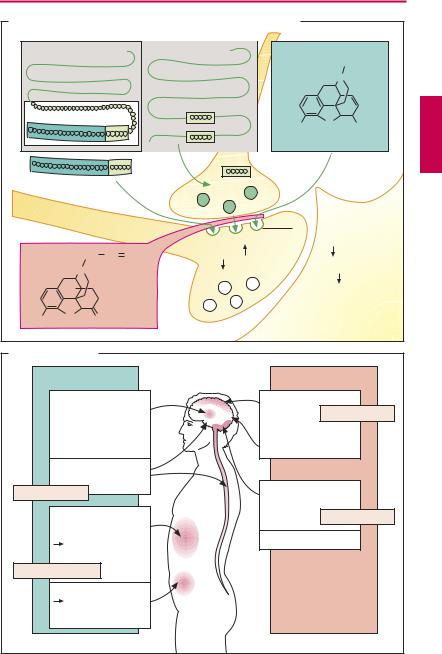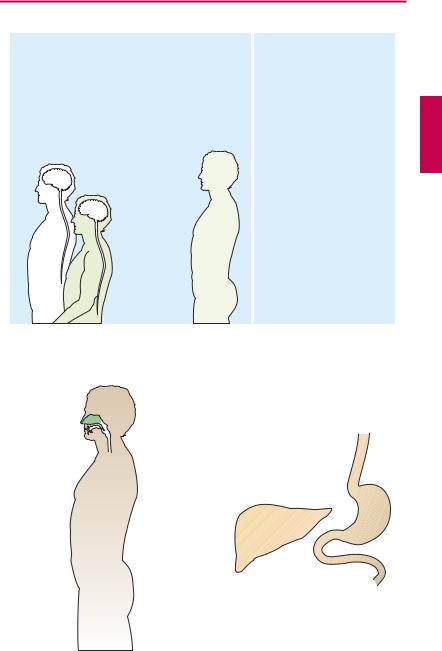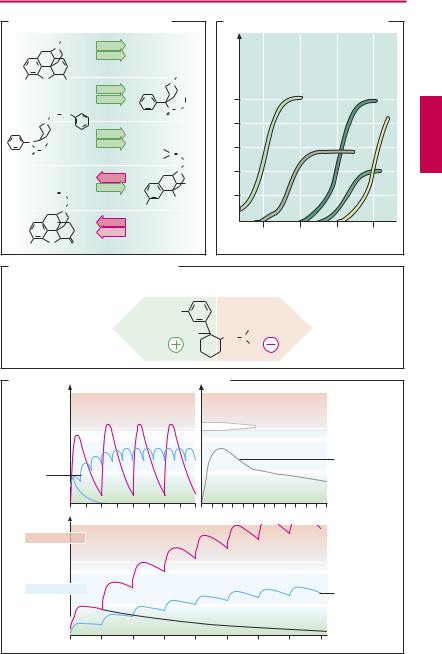
- •Preface to the 3rd edition
- •General Pharmacology
- •Systems Pharmacology
- •Therapy of Selected Diseases
- •Subject Index
- •Abbreviations
- •General Pharmacology
- •History of Pharmacology
- •Drug and Active Principle
- •The Aims of Isolating Active Principles
- •European Plants as Sources of Effective Medicines
- •Drug Development
- •Congeneric Drugs and Name Diversity
- •Oral Dosage Forms
- •Drug Administration by Inhalation
- •Dermatological Agents
- •From Application to Distribution in the Body
- •Potential Targets of Drug Action
- •External Barriers of the Body
- •Blood–Tissue Barriers
- •Membrane Permeation
- •Binding to Plasma Proteins
- •The Liver as an Excretory Organ
- •Biotransformation of Drugs
- •Drug Metabolism by Cytochrome P450
- •The Kidney as an Excretory Organ
- •Presystemic Elimination
- •Drug Concentration in the Body as a Function of Time—First Order (Exponential) Rate Processes
- •Time Course of Drug Concentration in Plasma
- •Time Course of Drug Plasma Levels during Repeated Dosing (A)
- •Time Course of Drug Plasma Levels during Irregular Intake (B)
- •Accumulation: Dose, Dose Interval, and Plasma Level Fluctuation (A)
- •Dose–Response Relationship
- •Concentration–Effect Curves (B)
- •Concentration–Binding Curves
- •Types of Binding Forces
- •Agonists—Antagonists
- •Other Forms of Antagonism
- •Enantioselectivity of Drug Action
- •Receptor Types
- •Undesirable Drug Effects, Side Effects
- •Drug Allergy
- •Cutaneous Reactions
- •Drug Toxicity in Pregnancy and Lactation
- •Pharmacogenetics
- •Placebo (A)
- •Systems Pharmacology
- •Sympathetic Nervous System
- •Structure of the Sympathetic Nervous System
- •Adrenergic Synapse
- •Adrenoceptor Subtypes and Catecholamine Actions
- •Smooth Muscle Effects
- •Cardiostimulation
- •Metabolic Effects
- •Structure–Activity Relationships of Sympathomimetics
- •Indirect Sympathomimetics
- •Types of
- •Antiadrenergics
- •Parasympathetic Nervous System
- •Cholinergic Synapse
- •Parasympathomimetics
- •Parasympatholytics
- •Actions of Nicotine
- •Localization of Nicotinic ACh Receptors
- •Effects of Nicotine on Body Function
- •Aids for Smoking Cessation
- •Consequences of Tobacco Smoking
- •Dopamine
- •Histamine Effects and Their Pharmacological Properties
- •Serotonin
- •Vasodilators—Overview
- •Organic Nitrates
- •Calcium Antagonists
- •ACE Inhibitors
- •Drugs Used to Influence Smooth Muscle Organs
- •Cardiac Drugs
- •Cardiac Glycosides
- •Antiarrhythmic Drugs
- •Iron Compounds
- •Prophylaxis and Therapy of Thromboses
- •Possibilities for Interference (B)
- •Heparin (A)
- •Hirudin and Derivatives (B)
- •Fibrinolytics
- •Intra-arterial Thrombus Formation (A)
- •Formation, Activation, and Aggregation of Platelets (B)
- •Inhibitors of Platelet Aggregation (A)
- •Presystemic Effect of ASA
- •Plasma Volume Expanders
- •Lipid-lowering Agents
- •Diuretics—An Overview
- •NaCl Reabsorption in the Kidney (A)
- •Aquaporins (AQP)
- •Osmotic Diuretics (B)
- •Diuretics of the Sulfonamide Type
- •Potassium-sparing Diuretics (A)
- •Vasopressin and Derivatives (B)
- •Drugs for Gastric and Duodenal Ulcers
- •Laxatives
- •Antidiarrheal Agents
- •Drugs Affecting Motor Function
- •Muscle Relaxants
- •Nondepolarizing Muscle Relaxants
- •Depolarizing Muscle Relaxants
- •Antiparkinsonian Drugs
- •Antiepileptics
- •Pain Mechanisms and Pathways
- •Eicosanoids
- •Antipyretic Analgesics
- •Nonsteroidal Anti-inflammatory Drugs (NSAIDs)
- •Cyclooxygenase (COX) Inhibitors
- •Local Anesthetics
- •Opioid Analgesics—Morphine Type
- •General Anesthesia and General Anesthetic Drugs
- •Inhalational Anesthetics
- •Injectable Anesthetics
- •Sedatives, Hypnotics
- •Benzodiazepines
- •Pharmacokinetics of Benzodiazepines
- •Therapy of Depressive Illness
- •Mania
- •Therapy of Schizophrenia
- •Psychotomimetics (Psychedelics, Hallucinogens)
- •Hypothalamic and Hypophyseal Hormones
- •Thyroid Hormone Therapy
- •Glucocorticoid Therapy
- •Follicular Growth and Ovulation, Estrogen and Progestin Production
- •Oral Contraceptives
- •Antiestrogen and Antiprogestin Active Principles
- •Aromatase Inhibitors
- •Insulin Formulations
- •Treatment of Insulin-dependent Diabetes Mellitus
- •Treatment of Maturity-Onset (Type II) Diabetes Mellitus
- •Oral Antidiabetics
- •Drugs for Maintaining Calcium Homeostasis
- •Drugs for Treating Bacterial Infections
- •Inhibitors of Cell Wall Synthesis
- •Inhibitors of Tetrahydrofolate Synthesis
- •Inhibitors of DNA Function
- •Inhibitors of Protein Synthesis
- •Drugs for Treating Mycobacterial Infections
- •Drugs Used in the Treatment of Fungal Infections
- •Chemotherapy of Viral Infections
- •Drugs for the Treatment of AIDS
- •Drugs for Treating Endoparasitic and Ectoparasitic Infestations
- •Antimalarials
- •Other Tropical Diseases
- •Chemotherapy of Malignant Tumors
- •Targeting of Antineoplastic Drug Action (A)
- •Mechanisms of Resistance to Cytostatics (B)
- •Inhibition of Immune Responses
- •Antidotes and Treatment of Poisonings
- •Therapy of Selected Diseases
- •Hypertension
- •Angina Pectoris
- •Antianginal Drugs
- •Acute Coronary Syndrome— Myocardial Infarction
- •Congestive Heart Failure
- •Hypotension
- •Gout
- •Obesity—Sequelae and Therapeutic Approaches
- •Osteoporosis
- •Rheumatoid Arthritis
- •Migraine
- •Common Cold
- •Bronchial Asthma
- •Emesis
- •Alcohol Abuse
- •Local Treatment of Glaucoma
- •Further Reading
- •Further Reading
- •Picture Credits
- •Drug Indexes

208 Opioids
Opioid Analgesics—Morphine Type
Sources of opioids. Morphine is an opium alkaloid (p.4). Besides morphine, opium contains alkaloids devoid of analgesic activity, e.g., the spasmolytic papaverine. All semisynthetic derivatives (hydromorphone) and fully synthetic derivatives (pentazocine, pethidine = meperidine, l-methadone, and fentanyl) that possess the analgesic effect of morphine are collectively referred to as opiates and opioids, respectively. The high analgesic effectiveness of xenobiotic opioids derives from their af nity for receptors normally acted upon by endogenous opioids (enkephalins, β-endorphin, dynorphins; A). Opioid receptors occur on nerve cells. They are found in various brain regions and the spinalmedulla,aswellasinintramuralnerve plexuses that regulate the motility of the alimentary and urogenital tracts. There are several types of opioid receptors, designated µ, δ, κ, which mediate the various opioid effects, and all belong to the superfamily of G-protein coupled receptors (p.66).
Endogenous opioids are peptidesthat are cleaved from the precursors, proenkephalin, pro-opiomelanocortin, and prodynorphin. All contain the amino acid sequence of the pentapeptides [Met]- or [Leu]-enkephalin (A). The effects of the opioids can be abolishedbyantagonists(e.g., naloxone; A), with the exception of buprenorphine.
Mode of action of opioids. Most neurons react to opioids with a hyperpolarization, reflecting an increase in K+ conductance. Ca2+ influx into nerve terminals during excitation is decreased, leading to a decreased release of transmittersand decreased synaptic activity (A). Depending on the cell population affected,thissynapticinhibition translates into a depressant or excitant effect (B).
Effects of opioids (B). The analgesic effect results from actions at the level of the spinal cord (inhibition of nociceptive impulse transmission) and the brain (disinhibition
of the descending antinociceptive system, attenuation of impulse spread, and inhibition of pain perception). Attention and ability to concentrate are impaired. There is a mood change, the direction of which depends on the initial condition. Aside from the relief associated with the abatement of strong pain, there is a feeling of detachment (floating sensation) and a sense of wellbeing (euphoria), particularly after intravenous injection and, hence, rapid build-up of drug levels in the brain. The desire to reexperience this state by renewed administration of drug may become overpowering: development of psychological dependence.
The attempt to quit repeated use of the drug results in withdrawal signs of both physical (e.g., cardiovascular disturbances) andpsychological(e.g., restlessness, anxiety, depression) nature.
Opioids meet the criteria of drugs producing dependence, that is, a psychological and physiologicalneedtocontinueuseofthedrug aswellasthecompulsiontoincreasethedose.
For these reasons, prescription of opioids is subject to special rules (Controlled Substances Act, USA; Narcotic Control Act, Canada; etc). Certain opioid analgesics such as codeine and tramadol may be prescribed in the usual manner, because of their lesser potential for abuse and development of dependence. Differences among opioids in ef - cacy and liability to cause dependence probably reflect differing patterns of af nity and intrinsic activity at individual receptor subtypes, as well as genetic variation of opioid receptors. A given substance does not necessarily act as an agonist or antagonist at each subtype;instead,itmaybehave asanagonist at one subtype and as a partial agonist/antagonist at another, or even as a pure antagonist (p.212). In particular, the addictive potential is determined by kinetic properties; only with rapid drug entry into the brain can the euphoriant “rush” be experienced. All high-potency opioids pose the risk of respiratory depression (paralysis of the respiratorycenter) after overdosage. Themaximally
Luellmann, Color Atlas of Pharmacology © 2005 Thieme
All rights reserved. Usage subject to terms and conditions of license.

|
|
|
|
|
|
Opioid Analgesics |
209 |
|
A. Action of endogenous and exogenous opioids at opioid receptors |
|
|
||||||
Proopiomelanocortin |
|
Proenkephalin |
Morphine |
|
||||
|
|
|
|
|
|
|
CH3 |
|
|
|
|
|
|
|
|
N |
|
|
β -Lipotropin |
|
|
|
3 |
|
6 |
|
|
|
|
|
|
|
|||
|
|
|
|
HO |
O |
OH |
||
|
|
|
|
|
|
|||
|
|
|
|
|
|
|
||
|
|
|
|
|
|
Enkephalin |
|
|
|
β -Endorphin |
|
|
|
|
|
|
|
|
|
|
|
|
|
Opioid receptors |
||
|
|
CH2 |
CH |
CH2 |
K+-permeability |
Ca2+-influx |
|
|
|
|
Excitability |
|
|
|
|||
|
|
N |
|
|
Release of |
|
|
|
|
|
|
|
|
|
|
||
|
|
|
|
|
transmitters |
|
||
|
HO |
|
|
|
|
|
||
|
|
|
|
|
|
|
|
|
|
O |
|
Antagonist |
|
|
|
|
|
HO |
O |
naloxone |
|
|
|
|
||
B. Effects of opioids |
|
|
|
|
|
|
||
Stimulant effects |
Mediated by |
Dampening effects |
|
opioid receptors |
|||
|
|
||
Vagal centers, |
|
Pain sensation |
|
Chemoreceptors |
|
Analgesic |
|
of area postrema |
|
||
|
|
||
Oculomotor |
|
|
|
center (Edinger– |
|
Mood |
|
Westphal nucleus) |
|
alertness |
|
Antinociceptive |
|
|
|
system |
|
|
|
Analgesic |
|
Respiratory center |
|
|
Cough center |
||
|
|
||
Smooth musculature |
|
Antitussive |
|
stomach |
|
|
|
bowel |
|
Emetic center |
|
spastic |
|
||
|
|
||
constipation |
|
|
|
Antidiarrheal |
|
|
|
Urinary tract |
|
|
|
possible |
|
|
|
impairment of |
|
|
|
micturition |
|
|
Luellmann, Color Atlas of Pharmacology © 2005 Thieme
All rights reserved. Usage subject to terms and conditions of license.

210 Opioids
possible extent of respiratory depression is thought to be less for partial agonists/antagonists (pentazocine, nalbuphine).
The cough-suppressant (antitussive) effect produced by inhibition of the cough reflex is independent of the effects on nociception or respiration (antitussives: codeine, noscapine).
Stimulation of chemoreceptors in the area postrema (p.342) results in vomiting, particularly after first-time administration or in the ambulant patient. The emetic effect disappears with repeated use because a direct inhibition of the emetic center then predominates.
Opioids elicit pupillary narrowing (miosis) by stimulating the parasympathetic portion (Edinger–Westphal nucleus) of the oculomotor nucleus.
The peripheral effects concern the motility and tonus of gastrointestinal smooth muscle; segmentation is enhanced but propulsive peristalsis is inhibited. The tonus of sphincter muscles is markedly raised (spastic constipation). The antidiarrhetic effect is used therapeutically (loperamide, p.180). Gastric emptying is delayed (pyloric spasm) and drainage of bile and pancreatic juice is impeded because the sphincter of Oddi contracts. Likewise, bladder function is affected; specifically bladder emptying is impaired owing to an increased tone of the vesicular sphincter.
Kinetics of opioids. The endogenous opioids (e.g., metenkephalin, leuenkephalin, β-en- dorphin) cannot be used therapeutically because, owing to their peptide nature, they are rapidly degraded or excluded from passage through the blood–brain barrier, thus preventing access to their sites of action even after parenteral administration (A). Morphine can be given orally or parenterally, as well as epidurally or intrathecally in the spinal cord. Fentanyl is of such potency and high tissue penetrability as to permit application in the form of a patch (transdermal
delivery system) (A). In opiate abuse, drug (“stuff,” “junk,” “smack,” “jazz,” “China white”; mostly heroin = diacetylmorphine) is injected intravenously (“mainlining”) to achieve the fastest possible rate of rise in brain concentration. Evidently, psychic effects (“kick,” “buzz,” “rush”) are especially intense with this route of delivery. The user may also resort to other more unusual routes: opium is smoked; heroin can be taken as snuff (B).
Metabolism (C). Like other opioids bearing a free hydroxyl group, morphine is conjugated to glucuronic acid and excreted renally. Glucuronidation of the OH group at position 6, unlike that at position 3, does not affect af nity for the receptors.
Tolerance. With repeated administration of opioids, their CNS effects undergo habituation (adaptation). In the course of therapy, progressively larger doses are thus needed to achieve the same degree ofpain relief. The peripheral effects are less altered by the development of tolerance, so that persistent constipation during prolonged use may force a discontinuation of analgesic therapy however urgently needed. Frequently laxatives must be prescribed.
Morphine antagonists and partial agonists.
The effectsofopioidscan be abolished bythe antagonists naloxone or naltrexone (A), irrespective of the receptor type involved. Given by itself, neither has any effect in normal subjects; however, in opioid-dependent subjects, both precipitate acute withdrawal signs. Because of its rapid presystemic elimination, naloxone is only suitable for parenteral use. Naltrexone is metabolically more stable and can be given orally. Naloxone is effective as antidote in the treatment of opioid-induced respiratory paralysis. Since it is more rapidly eliminated than most opioids, repeated doses may be needed. Naltrexone may be used as adjunct in withdrawal therapy.
Luellmann, Color Atlas of Pharmacology © 2005 Thieme
All rights reserved. Usage subject to terms and conditions of license.

Opioids 211
A. Opioids: mode of application and bioavailability
|
Met-Enkephalin |
|
Morphine |
|
|
Fentanyl |
||||
|
|
|
|
|
|
Carfentanyl |
|
|
||
Tyr |
Gly |
Gly |
Phe |
Met |
|
CH3 |
|
|
CH2 |
CH2 |
|
|
O |
N |
|
|
|||||
|
|
|
|
|
|
N |
|
|
||
|
|
|
|
|
|
H3C |
C |
|
|
|
|
|
|
|
|
O |
|
|
N |
CH3 |
|
|
|
|
|
HO |
OH |
|
C |
CH2 |
|
|
|
|
|
|
|
|
|
||||
|
|
|
|
|
|
|
|
|
||
|
|
|
|
|
|
|
|
O |
|
|
B. Application and rate of disposition |
Opioid |
Nasal |
mucosa, |
e.g., heroin |
sniffing |
Intravenous |
application |
“Mainlining” |
Bronchial |
mucosa |
e.g., opium |
smoking |
C. Metabolism of morphine |
Oral |
application |
Morphine |
Morphine 6- |
glucuronide |
Morphine 3- |
glucuronide |
Luellmann, Color Atlas of Pharmacology © 2005 Thieme
All rights reserved. Usage subject to terms and conditions of license.

Uses. Two conditions must be distinguished:
(1) Acute severe pain after trauma (accidents), myocardial infarction, etc. and lifethreatening pulmonary edema requiring inhibition of the respiratory center. For these indications, administration of morphine (intravenously or subcutaneously) in suf cient amounts is appropriate. With short-term use, development of tolerance or dependence is of no concern.
(2) Severe chronic pain, especially in cancerpatients.Inthesecases,theaimistoestablish a constant plasma level of opioid for a prolonged period. Drug must be given before the appearance of pain, not after the patient has begun to suffer from intolerable pain. Like some of the other opioids (hydromorphone, meperidine, pentazocine, codeine), morphine is rapidly eliminated; its duration of action is about 4 hours. To achieve continuous analgesia, these substances would have to be given every 4 hours. For treatment of severe chronic pain states, use of morphine (or oxycodone) in controlled release form isthemostadvantageousregimen because (a) the slow rise in serum levels avoids the subjective “rush” sensation and, hence, the development of “addiction” (psychological dependence); (b) the effect isprolonged;(c)underthiscondition,anincreased proportionofmorphineisconvertedtothe6glucuronide and contributes to the central effect; and (d) the patient can independently control intake of morphine (i.e., next sus- tained-release tablet before severe pain reemerges). If a cancer patient has reached a terminal state, development of tolerance is quite acceptable and can easily be compensated. In amoribundperson, acertain degree of euphoria, possibly associated with diminishedvigilance,appearsethicallyacceptable.
Under special conditions (oral route unavailable; intolerable peripheral side effects), opioids may be administered by continuous infusion (pump) or applied near the spinal cord under control by the patient. The advantage is much lower dosage (300-fold) and constant therapeutic level; the disad-
Luellmann, Color Atlas of Pharmacology © 2005vantageThiemeis the need for a catheter.
All rights reserved. Usage subject to terms and conditions of license.

|
|
|
|
|
|
|
|
|
Opioids |
|
213 |
A. Opioids: µ- and κ -receptor ligands |
|
|
B. Opiods: dose-response relationship |
||||||||
|
|
C H3 |
µ |
|
|
|
|
|
|
|
|
|
N |
|
|
|
|
|
|
|
|
|
|
|
|
|
κ |
|
|
|
|
Fentanyl |
|
Morphine |
Meperidine |
|
|
|
Morphine |
|
|
C H3 |
|
|
|||
|
O |
|
|
|
|
|
|
||||
HO |
OH |
µ |
|
N |
|
|
|||||
|
|
|
|
||||||||
|
|
|
|
|
|
|
|
||||
|
|
|
κ |
|
|
C H3 |
|
|
|||
|
|
|
|
C |
C H2 |
|
|
||||
|
CH2 |
CH2 |
Meperidine |
|
O |
|
|
|
Buprenorphine |
|
|
|
O |
|
|
Analgesic effect |
|
|
|
||||
|
N |
|
|
|
|
|
|
|
|||
|
|
|
|
|
|
|
|
|
|||
|
|
|
µ |
|
|
|
|
|
|
||
N |
CH3 |
|
κ |
|
|
|
|
|
Pentazocine |
||
C |
CH2 |
|
H 3C |
|
|
|
|
||||
|
Fentanyl |
C |
C H |
|
|
||||||
O |
|
|
H 3C |
|
|
||||||
|
|
|
C H 2 |
|
|
||||||
|
|
|
|
|
|
|
|||||
|
|
|
|
|
|
|
|
||||
|
|
|
µ |
|
|
N |
|
|
|||
|
|
|
|
|
|
|
|
||||
|
|
|
κ |
|
|
C H 3 |
|
|
|||
|
H 2C |
C H |
|
|
|
|
|
||||
|
Pentazocine |
|
|
C H 3 |
|
|
|
|
|
||
|
|
C H 2 |
|
|
|
|
|
|
|
||
|
|
H O |
|
|
|
|
|
|
|
|
|
|
|
N |
|
|
|
|
|
|
|
|
|
|
|
|
|
|
|
|
|
|
|
|
|
|
H O |
|
µ |
|
|
|
|
|
|
|
|
|
|
|
κ |
|
|
|
0.1 |
1 |
10 |
100 |
|
HO |
O |
O |
Naloxone |
|
|
|
|
Dose (mg) |
|
|
|
|
|
|
|
|
|
|
|||||
C. Enantioselective effects of tramadol
Agonist |
Serotonin |
at µ-opioid |
reuptake |
receptors |
inhibitor |
Racemate of tramadol
H3CO |
|
|
Norepinephrine |
|
HO |
|
CH3 |
reuptake inhibitor, |
|
C H 2 |
N |
α 2-Agonist |
||
|
||||
|
|
CH3 |
|
D. Morphine and methadone during chronic intake
Morphine |
Morphine |
|
Release |
High dose  every 12 h
every 12 h
Timed-
release
Low dose formulation every 4 h
12 |
24 |
36 |
hours |
4 |
8 |
12 |
16 |
20 24 hours |
Drug concentration in plasma
Intoxication |
Analgesia

 Methadone t1/2 = 55 h high dose
Methadone t1/2 = 55 h high dose
Methadone low dose
1 |
2 |
3 |
4 |
5 days |
Luellmann, Color Atlas of Pharmacology © 2005 Thieme
All rights reserved. Usage subject to terms and conditions of license.
